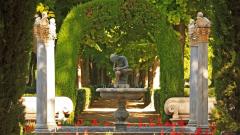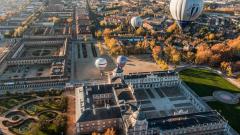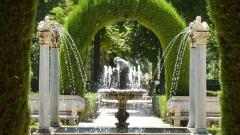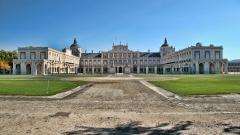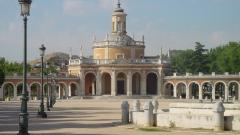Aranjuez
Aranjuez is a city located in the south of the Community of Madrid, 47 km from the capital, located between the rivers Tajo and Jarama. The municipality has an area of 189 km² and exceeds 60,000 inhabitants. This privileged location has been fundamental for the development of the ‘Real Sitio’ and ‘Villa’, title that it has held since 1899.
The site has a great historical value, the oldest vestiges that have been found have a prehistoric origin (‘piedras del rayo’), and it is believed that the first populations that settled there, had agriculture as a way of life as well as the harvest of salt and sheperding. Also, during the Roman period it was postulated as a nucleus of agricultural exploitation and strategic point for some of its roads.
It was during the Middle Ages, when the territory passed to the hands of the Order of Santiago, whose masters establish the town as their place of rest and recreation and began the construction of the first monuments, gardens and ponds.
The Spanish crown regained control of the city thanks to Fernando "the Catholic," but it was during the reign of Felipe II, when the city resurfaces. He included it within its network of Royal Sites, proposed a new territorial planning and piping system for rivers and gardens, and raises Palace. All these reforms turned the place into a modern city, but with large natural spaces that were used by The Bourbons for disconnection, parties, navigation and hunting.
During the eighteenth century, the town had its great heyday and The Palace, the most emblematic building, was the spring residence of Philip V, who interspersed, within its walls, his affairs of state with hunting, fishing and long horseback rides. His son Fernando VI and more especially his wife fell in love with the ‘Real Sitio’ and implemented a General Plan that turned it into a Courtesan City.
Through another period of reforms, managed by Italian architect Giacomo Bonavía, it became a point of reference for musical, theatrical and majestic royal celebrations that reached an international impact.
With the arrival to the throne of Carlos III, the previous era of cultural splendor ended, and a new phase of remodeling headed by Francesco Sabatini began. The intervention of the famous architect brought the construction of the Patio de Honor, of patent French influence, and the Royal Chapel, which gave it its current image.
These modifications weren’t limited only to the Palace, but also extended throughout the city, where houses, hospices, chapels, convents, barracks and House of Employees (now City Hall) were built. Other buildings were created ,such as ‘El Real Cortijo de San Isidro’ and ‘Campo Flamenco’ in the ‘Dehesa de Otos’.
During the reign of Carlos IV, architectural innovations were added in all the Royal Sites. ‘La Casita del Labrador’ was built, a complete remodeling of the gardens was done, and fountains and other buildings were created in the town.
In 1835 the City Council was definitively established and during the 19th century, with the aim of promoting industrial development, the government built the Madrid-Aranjuez railway line, concluded in 1851. Nowadays, the train-path has been converted into a tourist attraction, ‘El tren de la Fresa’ which runs through the town on weekends in spring and autumn, offering passengers four different routes.
Its past as a royal settlement, has granted an exquisite cultural landscape, however, it was declared a World Heritage Site by UNESCO in 2001, this heritage is the basis of a varied and attractive offer.
Starting with the aforementioned Royal Palace, a National Heritage monument with more visits in 2017, where throughout its rooms we can see great pictorial works, an exuberant and beautiful ornamentation, excellent pieces of porcelain, as well as a multitude of works of art, covering various styles, Baroque, Empire or Chinese among others. We will also have the possibility of examining the furniture of the period, armchairs beds, lamps, etc.
Inside the same Palace we find the ‘Casa del Labrador’, a beautiful palace finished in 1800, where ornamentation aside, we can admire the Billiard Room, the Ballroom or the Maria Luisa Hall as the most outstanding rooms.
Royal Barges Museum is another interesting place where we will find a large number of boats of exceptional artistic value that were used by the monarchs for navigation.
Apart from these, other buildings stand out, such as the bullring, together with its museum. The Royal Church of San Antonio and the Church of the ‘Virgen de las Angustias’, which are highlighted as religious monuments.
It has an excellent natural environment, composed of large gardens (‘Jardin del Principe’, Garden of the Island, Garden of Isabel II), historic groves, which are part of a Natural Route, orchards of strawberries and asparagus, and tree-lined walks. This whole ecosystem has also been crucial for the development of active tourism, offering the visitor a multitude of sports activities, canoeing, multi-adventure, natural routes on foot on horseback or by bicycle and even golf.
Another place of interest to review, is the Ontígola Sea, a wetland located on the outskirts of the municipality, which together with the reserve of the Regajal are qualified as a Natural Reserve and serves as a refuge for a wide range of butterflies, some in danger of extinction, due to which, it has become a place of global reference for experts in the field. We can also observe a great variety of flora and aquatic avifauna.
It also has a vast agenda of events that feed both tourists and residents with a large range of activities, we highlight its annual festival of classical music, the representation of the riot of Aranjuez and the Royal Spring Days.
After this summary, we can assert that Aranjuez is an outstanding tourist destination within the Community of Madrid that combines history and modernity, which has managed to maintain its heritage, take advantage of its past and,and at the same time, adapt to new trends in the tourism sector and become into an integral destination.

